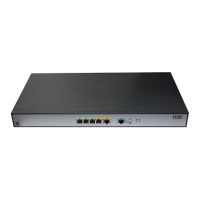11
{ Replace cables.
{ Connect the Tx and Rx ends of the cable. Identify whether the interface can perform self
loopback. If self loopback succeeds, the cable has no problems. For how to perform self
loopback, see “Troubleshooting through looping.”
2. Identify whether the
cable impedance matches the interface impedance.
a. Execute the display controller or display fe1 command to view the interface
impedance (text in blue in the command output).
[H3C] display controller E1 1/0/0
E1 1/0/0 current state :DOWN
Description : E1 1/0/0 Interface
Basic Configuration:
Work mode is E1 framed, Cable type is 120 Ohm balanced.
b. Replace the cable or adjust the DIP switch on the card to ensure that the cable impedance
matches the interface impedance. (For an HMIM-8E1T1 card, use the hardware jumper and
the cable-type command to identify the card impedance.)
Interface type: E1 interface
Command: cable-type { 75 | 120 }
Parameters:
− 75: Matches 75-Ω transmission lines.
− 120: Matches 120-Ω transmission lines.
3. Identify whether the cable length matches the configuration.
An E1/T1 interface poses a limit on the cable length. Typically, the maximum length cannot
exceed 500 meters. A longer cable will cause more serious signal attenuation. In this case, you
need to compensate the signal or connect an external CSU. The router provides the cable
command to set the attenuation or length for the transmission line of an interface. This
command configures the wave pattern for transmitted signals to adapt to different transmission
requirements. Use this command according to the quality of the received signals. If the received
signals are of good quality, use the default settings.
{ Interface type: E1 interface
Command: cable { long | short }
Parameters:
− long: Matches 199.6-meter (655-feet) and longer cable length.
− short: Matches a cable length shorter than 199.6 meters (655 feet).
{ Interface type: T1/T1-F interface
Command: cable { long { 0db | -7.5db | -15db | -22.5db } | short { 133ft | 266ft
| 399ft | 533ft | 655ft } }
Parameters
− long: Matches 199.6-meter (655-feet) and longer cable length. The options for this
parameter include 0db, -7.5db, -15db, and -22.5db. The attenuation is selected
depending on the signal quality received at the receiving end. A poorer line quality
results in a more serious signal attenuation. In this case, you need to compensate the
signal attenuation. No external CSU is needed.
− short: Matches a cable length shorter than 199.6 meters (655 feet). The options for this
parameter include 133ft, 266ft, 399ft, 533ft, and 655ft. The length is selected
depending on the actual transmission distance.
Troubleshooting the configuration
1. Verify that the local end and peer end have the same configuration.

